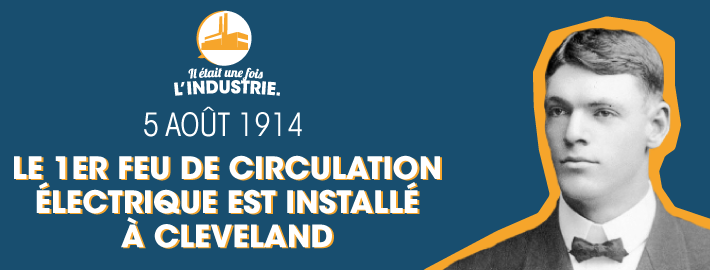GLOBAL
INDUSTRIE
News
Share on

5 August 1914: the first electric traffic light is installed in Cleveland
What happened this week in the History of Industry? It is to answer this question that Global Industrie invites you to rediscover, every week, a key event which occurred around this time… in another age. This week, we take you on "road trip" 107 years back in time to the heart of the United States, on the 5th of August 1914 in Cleveland, Ohio, where the world’s first electric traffic lights were installed. At least officially…
A FIRST ATTEMPT WHICH MISFIRED
The story begins in fact more than 150 years ago on the other side of the Atlantic, to be precise in London on the 10th of December 1868, at the corner of Bridge Street and Palace Yard. That was the day on which the very first traffic light, invented by John Peake Knight, was used. It took the form of a pivoting red and green gas lantern devised for the ambitious purpose of bringing order to the British capital’s incessant horse-drawn traffic. The only problem was that this first model, operated by a policeman stationed nearby, ran on gas… and ended up accidentally exploding less than one month later, on the 2nd of January 1869, seriously injuring the officer. This effectively put an end to the experiment.
Following this dismal failure, it was not until 1910 that the American Ernest Sirrine patented a non-luminous signal displaying the words "Stop" or "Proceed". Without great success, until one of his compatriots looked into the problem…
POLICEMEN WITH BRIGHT IDEAS
His name was Lester Wire and he was a policeman by profession, or more exactly head of the traffic squad in Utah’s capital, Salt Lake City, a city which was famous not only for its Mormons but also for its traffic jams, and not just of buggies. Facing complaints from his men who had to control the traffic in the city, even in the worst weather conditions, in 1912 he had the idea of making their job easier by creating a system of lights powered by electricity.
The first model was very basic: it was a wooden box with a removable top allowing replacement of the bulbs painted green and red, the colors in use in maritime law and on railways. It was mounted on a pole, connected to the trolleybus wiring and operated by a policeman stationed in the warmth and safety of a hut on the sidewalk.
This local initiative immediately impressed the American Traffic Signal Company, which decided to develop it nationally. Thus it was that on the 5th of August 1914 the first official electric traffic lights were installed in Cleveland, at the corner of East 105th Street and Euclid Avenue, before spreading to other major cities.
They were still two-colored and controlled manually by a policeman in a booth, a buzzer sounding when the lights changed. It was not until six years later, in 1920, that another policeman, this time in Detroit, had the idea of installing an intermediate orange light. Even then, it was some time before this third light was generally adopted.
BLINDED BY THE LIGHT
In France, we owe the appearance of this system to the Marseille inventor Léon Foenquinos, who was also responsible for the amphibious tank and… lotteries. He described it thus in 1920: "three-meter high posts, on which luminous and audible electrical signals shall be attached, shall be installed at the corners of street intersections."
Thus it was that on the 5th of May 1923, at the intersection of Boulevard Saint-Denis and Boulevard Sébastopol in Paris, the first French traffic light was installed. It was red and accompanied by a buzzer, green and orange not appearing until ten years later.
"My wife doesn’t stop at traffic lights. She says that when you’ve seen one, you’ve seen them all"– George Burns
2021.08.16